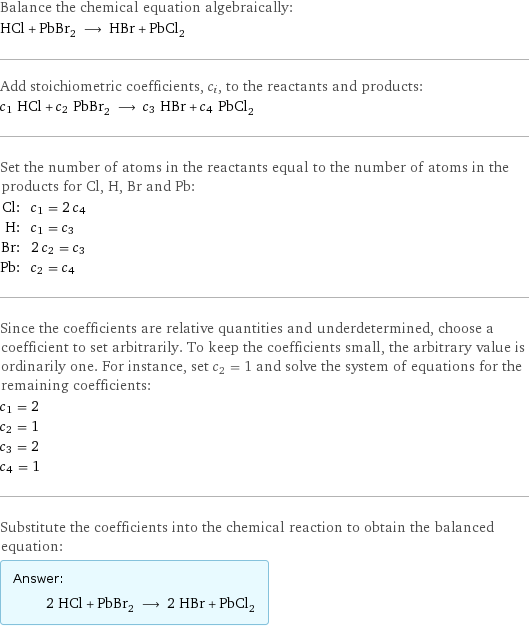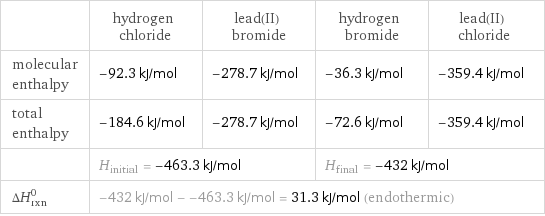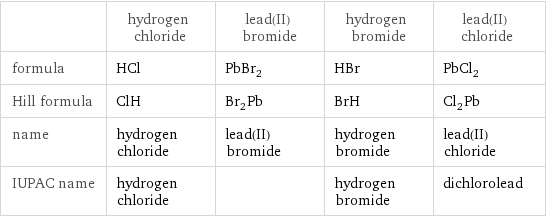Input interpretation

HCl hydrogen chloride + PbBr_2 lead(II) bromide ⟶ HBr hydrogen bromide + PbCl_2 lead(II) chloride
Balanced equation

Balance the chemical equation algebraically: HCl + PbBr_2 ⟶ HBr + PbCl_2 Add stoichiometric coefficients, c_i, to the reactants and products: c_1 HCl + c_2 PbBr_2 ⟶ c_3 HBr + c_4 PbCl_2 Set the number of atoms in the reactants equal to the number of atoms in the products for Cl, H, Br and Pb: Cl: | c_1 = 2 c_4 H: | c_1 = c_3 Br: | 2 c_2 = c_3 Pb: | c_2 = c_4 Since the coefficients are relative quantities and underdetermined, choose a coefficient to set arbitrarily. To keep the coefficients small, the arbitrary value is ordinarily one. For instance, set c_2 = 1 and solve the system of equations for the remaining coefficients: c_1 = 2 c_2 = 1 c_3 = 2 c_4 = 1 Substitute the coefficients into the chemical reaction to obtain the balanced equation: Answer: | | 2 HCl + PbBr_2 ⟶ 2 HBr + PbCl_2
Structures

+ ⟶ +
Names

hydrogen chloride + lead(II) bromide ⟶ hydrogen bromide + lead(II) chloride
Reaction thermodynamics
Enthalpy

| hydrogen chloride | lead(II) bromide | hydrogen bromide | lead(II) chloride molecular enthalpy | -92.3 kJ/mol | -278.7 kJ/mol | -36.3 kJ/mol | -359.4 kJ/mol total enthalpy | -184.6 kJ/mol | -278.7 kJ/mol | -72.6 kJ/mol | -359.4 kJ/mol | H_initial = -463.3 kJ/mol | | H_final = -432 kJ/mol | ΔH_rxn^0 | -432 kJ/mol - -463.3 kJ/mol = 31.3 kJ/mol (endothermic) | | |
Gibbs free energy

| hydrogen chloride | lead(II) bromide | hydrogen bromide | lead(II) chloride molecular free energy | -95.3 kJ/mol | -261.9 kJ/mol | -53.4 kJ/mol | -314.1 kJ/mol total free energy | -190.6 kJ/mol | -261.9 kJ/mol | -106.8 kJ/mol | -314.1 kJ/mol | G_initial = -452.5 kJ/mol | | G_final = -420.9 kJ/mol | ΔG_rxn^0 | -420.9 kJ/mol - -452.5 kJ/mol = 31.6 kJ/mol (endergonic) | | |
Equilibrium constant
![Construct the equilibrium constant, K, expression for: HCl + PbBr_2 ⟶ HBr + PbCl_2 Plan: • Balance the chemical equation. • Determine the stoichiometric numbers. • Assemble the activity expression for each chemical species. • Use the activity expressions to build the equilibrium constant expression. Write the balanced chemical equation: 2 HCl + PbBr_2 ⟶ 2 HBr + PbCl_2 Assign stoichiometric numbers, ν_i, using the stoichiometric coefficients, c_i, from the balanced chemical equation in the following manner: ν_i = -c_i for reactants and ν_i = c_i for products: chemical species | c_i | ν_i HCl | 2 | -2 PbBr_2 | 1 | -1 HBr | 2 | 2 PbCl_2 | 1 | 1 Assemble the activity expressions accounting for the state of matter and ν_i: chemical species | c_i | ν_i | activity expression HCl | 2 | -2 | ([HCl])^(-2) PbBr_2 | 1 | -1 | ([PbBr2])^(-1) HBr | 2 | 2 | ([HBr])^2 PbCl_2 | 1 | 1 | [PbCl2] The equilibrium constant symbol in the concentration basis is: K_c Mulitply the activity expressions to arrive at the K_c expression: Answer: | | K_c = ([HCl])^(-2) ([PbBr2])^(-1) ([HBr])^2 [PbCl2] = (([HBr])^2 [PbCl2])/(([HCl])^2 [PbBr2])](../image_source/b19396f60a388abd1051a883282e9473.png)
Construct the equilibrium constant, K, expression for: HCl + PbBr_2 ⟶ HBr + PbCl_2 Plan: • Balance the chemical equation. • Determine the stoichiometric numbers. • Assemble the activity expression for each chemical species. • Use the activity expressions to build the equilibrium constant expression. Write the balanced chemical equation: 2 HCl + PbBr_2 ⟶ 2 HBr + PbCl_2 Assign stoichiometric numbers, ν_i, using the stoichiometric coefficients, c_i, from the balanced chemical equation in the following manner: ν_i = -c_i for reactants and ν_i = c_i for products: chemical species | c_i | ν_i HCl | 2 | -2 PbBr_2 | 1 | -1 HBr | 2 | 2 PbCl_2 | 1 | 1 Assemble the activity expressions accounting for the state of matter and ν_i: chemical species | c_i | ν_i | activity expression HCl | 2 | -2 | ([HCl])^(-2) PbBr_2 | 1 | -1 | ([PbBr2])^(-1) HBr | 2 | 2 | ([HBr])^2 PbCl_2 | 1 | 1 | [PbCl2] The equilibrium constant symbol in the concentration basis is: K_c Mulitply the activity expressions to arrive at the K_c expression: Answer: | | K_c = ([HCl])^(-2) ([PbBr2])^(-1) ([HBr])^2 [PbCl2] = (([HBr])^2 [PbCl2])/(([HCl])^2 [PbBr2])
Rate of reaction
![Construct the rate of reaction expression for: HCl + PbBr_2 ⟶ HBr + PbCl_2 Plan: • Balance the chemical equation. • Determine the stoichiometric numbers. • Assemble the rate term for each chemical species. • Write the rate of reaction expression. Write the balanced chemical equation: 2 HCl + PbBr_2 ⟶ 2 HBr + PbCl_2 Assign stoichiometric numbers, ν_i, using the stoichiometric coefficients, c_i, from the balanced chemical equation in the following manner: ν_i = -c_i for reactants and ν_i = c_i for products: chemical species | c_i | ν_i HCl | 2 | -2 PbBr_2 | 1 | -1 HBr | 2 | 2 PbCl_2 | 1 | 1 The rate term for each chemical species, B_i, is 1/ν_i(Δ[B_i])/(Δt) where [B_i] is the amount concentration and t is time: chemical species | c_i | ν_i | rate term HCl | 2 | -2 | -1/2 (Δ[HCl])/(Δt) PbBr_2 | 1 | -1 | -(Δ[PbBr2])/(Δt) HBr | 2 | 2 | 1/2 (Δ[HBr])/(Δt) PbCl_2 | 1 | 1 | (Δ[PbCl2])/(Δt) (for infinitesimal rate of change, replace Δ with d) Set the rate terms equal to each other to arrive at the rate expression: Answer: | | rate = -1/2 (Δ[HCl])/(Δt) = -(Δ[PbBr2])/(Δt) = 1/2 (Δ[HBr])/(Δt) = (Δ[PbCl2])/(Δt) (assuming constant volume and no accumulation of intermediates or side products)](../image_source/4ef7ecf21056952e5fd4ca66d3ffd8fe.png)
Construct the rate of reaction expression for: HCl + PbBr_2 ⟶ HBr + PbCl_2 Plan: • Balance the chemical equation. • Determine the stoichiometric numbers. • Assemble the rate term for each chemical species. • Write the rate of reaction expression. Write the balanced chemical equation: 2 HCl + PbBr_2 ⟶ 2 HBr + PbCl_2 Assign stoichiometric numbers, ν_i, using the stoichiometric coefficients, c_i, from the balanced chemical equation in the following manner: ν_i = -c_i for reactants and ν_i = c_i for products: chemical species | c_i | ν_i HCl | 2 | -2 PbBr_2 | 1 | -1 HBr | 2 | 2 PbCl_2 | 1 | 1 The rate term for each chemical species, B_i, is 1/ν_i(Δ[B_i])/(Δt) where [B_i] is the amount concentration and t is time: chemical species | c_i | ν_i | rate term HCl | 2 | -2 | -1/2 (Δ[HCl])/(Δt) PbBr_2 | 1 | -1 | -(Δ[PbBr2])/(Δt) HBr | 2 | 2 | 1/2 (Δ[HBr])/(Δt) PbCl_2 | 1 | 1 | (Δ[PbCl2])/(Δt) (for infinitesimal rate of change, replace Δ with d) Set the rate terms equal to each other to arrive at the rate expression: Answer: | | rate = -1/2 (Δ[HCl])/(Δt) = -(Δ[PbBr2])/(Δt) = 1/2 (Δ[HBr])/(Δt) = (Δ[PbCl2])/(Δt) (assuming constant volume and no accumulation of intermediates or side products)
Chemical names and formulas

| hydrogen chloride | lead(II) bromide | hydrogen bromide | lead(II) chloride formula | HCl | PbBr_2 | HBr | PbCl_2 Hill formula | ClH | Br_2Pb | BrH | Cl_2Pb name | hydrogen chloride | lead(II) bromide | hydrogen bromide | lead(II) chloride IUPAC name | hydrogen chloride | | hydrogen bromide | dichlorolead
Substance properties

| hydrogen chloride | lead(II) bromide | hydrogen bromide | lead(II) chloride molar mass | 36.46 g/mol | 367 g/mol | 80.912 g/mol | 278.1 g/mol phase | gas (at STP) | solid (at STP) | gas (at STP) | solid (at STP) melting point | -114.17 °C | 371 °C | -86.8 °C | 501 °C boiling point | -85 °C | 892 °C | -66.38 °C | 950 °C density | 0.00149 g/cm^3 (at 25 °C) | 6.66 g/cm^3 | 0.003307 g/cm^3 (at 25 °C) | 5.85 g/cm^3 solubility in water | miscible | | miscible | surface tension | | | 0.0271 N/m | dynamic viscosity | | 0.0088 Pa s (at 382 °C) | 8.4×10^-4 Pa s (at -75 °C) |
Units
